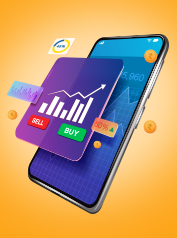Explore what a DP ID means, its role in the demat ecosystem, and why it’s essential for trading, securities holding, and seamless investment operations.
In the digital era of investing, demat accounts have become the foundation of stock market participation in India. These accounts allow investors to hold, buy, and sell securities electronically. But at the heart of a demat account lies a lesser-known yet critical component: the DP ID.
DP ID means Depository Participant Identification Number. DP ID in a demat account number forms a core part of it and plays a crucial role in ensuring accurate and secure transactions through regulated depositories like NSDL (National Securities Depository Limited) and CDSL (Central Depository Services Limited), which operate under the purview of SEBI. Investors access these systems via their Depository Participants (DPs).
This article breaks down what DP ID means, its structure, how it differs from a client ID, and where it’s used—from IPO applications to pledging shares. Whether you’re a first-time investor or managing your own portfolio, understanding DP ID helps you stay informed about how your demat account functions in the securities ecosystem.
A DP ID (Depository Participant Identification) is a unique number assigned to each Depository Participant (DP) by the depository they are registered with. DPs are intermediaries between investors and the central depositories (NSDL or CDSL).
The DP ID does not belong to the investor—it identifies the firm (e.g., bank, broker, or NBFC) through which the investor’s demat account is maintained.
NSDL assigns DP IDs with a prefix: INxxxxxx
CDSL assigns an 8-digit numeric DP ID: xxxxxxxx
Your demat account number is not just one identifier. It’s a combination of two elements:
Component |
Description |
|---|---|
DP ID |
Unique to the Depository Participant (your DP) |
Client ID |
Unique to you as a customer of the DP |
Here’s how the structure varies between NSDL and CDSL demat accounts:
Demat Account = DP ID + Client ID
Example: IN30256712345678
DP ID = IN302567
Client ID = 12345678
Demat Account = 16-digit numeric
Example: 1204567801234567
DP ID = 12045678
Client ID = 01234567
Many investors confuse DP ID with their own account number. The difference is simple yet significant:
Aspect |
DP ID |
Client ID |
|---|---|---|
Assigned to |
Depository Participant |
Individual Investor |
Purpose |
Identifies the DP (broker/bank) |
Identifies your account within DP |
Fixed or Unique |
Same for all clients of that DP |
Unique for each demat account |
Together, these form your Beneficiary Owner Identification Number (BO ID)—used for executing all transactions via your demat account.
BO ID or Beneficiary Owner ID, is a unique identifier used in NSDL and CDSL systems, and corresponds to your demat account number in most investor interactions. It is used across platforms, forms, and authorisation systems such as:
IPO applications via UPI
Securities pledging and TPIN generation
Holding statements and transaction authentication
Income Tax filings (for capital gains reporting)
Formula (BO ID):
For NSDL: BO ID = IN + 6-digit DP ID + 8-digit Client ID
For CDSL: BO ID = 8-digit DP ID + 8-digit Client ID = 16-digit Demat Account Number
DP ID plays a central role in enabling routing, validation, and settlement in the depository ecosystem. It enables:
Whether you’re buying shares or redeeming mutual funds, the DP ID ensures that securities are routed via the correct Depository Participant.
When pledging securities for margin or loans, the system verifies the DP ID as part of the holding authorisation process via TPIN (Transaction PIN).
DP ID is used by SEBI, NSDL, and CDSL to monitor holdings, enforce compliance, and manage audit trails.
For dividends, bonus shares, or rights issues, DP ID helps map your holdings correctly so benefits are not misdirected.
Your DP ID plays a key role in various demat-related transactions. The table below shows common use cases where your DP ID is required and explains why it's needed in each situation.
Use Case |
Why DP ID is Needed |
|---|---|
IPO Application |
BO ID includes DP ID; used in IPO forms or UPI apps |
Pledging/TPIN Generation |
Required to authorise sale of pledged securities |
Securities Transfer |
Ensures right depository receives/credits the shares |
Mutual Fund or ETF Transactions |
Part of demat mapping during redemption or allocation |
Tax Reporting & Capital Gains Filing |
Identifies your account for reconciliation and audit |
From IPOs to tax filings, the DP ID ensures your transactions are mapped accurately across systems and platforms.
Here’s how you can locate your DP ID if unsure:
1. Welcome Letter or Email: When your demat account is opened, your broker/DP sends a letter containing your DP ID.
2. Demat Holding Statement: Monthly or quarterly account statements list the DP ID.
3. Broker’s Portal: Login to your trading or DP account to view full demat details.
4. CDSL/NSDL Website Login: Use your BO ID to log in and retrieve DP ID details.
5. Customer Support: If you are unable to find it, contact your broker or DP directly.
The Securities and Exchange Board of India (SEBI) is the regulatory body overseeing depositories and DPs. It:
Grants registration to DPs
Assigns/approves DP ID numbers
Ensures client data and transaction integrity
Mandates annual audits and reporting to detect misuse or duplication
Although a demat account holds your securities and a trading account executes orders, they are often opened together through the same platform.
The DP ID links your trading activity with your holding account, enabling:
Buy orders → Allocation into demat via DP ID
Sell orders → Verification via TPIN + DP ID + Client ID
Smooth transfer of securities after settlement (T+2 model)
Many investors confuse the DP ID with their full demat account number or misunderstand its function. The table below clears up some frequent misconceptions and provides accurate clarifications.
Misunderstanding |
Clarification |
|---|---|
DP ID is the entire demat account |
It’s just a part of the full BO ID |
DP ID is unique to every user |
It is the same for all users under that DP |
You can change DP ID anytime |
Only possible by changing to a different DP |
DP ID is confidential |
It’s not private, but should only be shared securely |
Understanding the role and limits of a DP ID could help you avoid errors in IPO applications, pledging, and account transfers.
The DP ID is a critical component in your investment journey. Though it may seem technical, it has a very practical role—from ensuring secure transactions to validating identity during pledging, IPO applications, and beyond. By understanding how your DP ID connects to your client ID and full demat account number, you gain deeper clarity and control over your investments.
Whether you’re new to the stock market or a self-managed investor, this awareness helps you interact confidently with brokers, depositories, and platforms in a compliant, well-informed manner.
This content is for informational purposes only and the same should not be construed as investment advice. Bajaj Finserv Direct Limited shall not be liable or responsible for any investment decision that you may take based on this content.
It is the identification number given to your Depository Participant (broker or bank). It forms part of your full demat account number.
DP ID identifies the institution (broker/DP); client ID identifies you. Together they make your demat account number.
No. NSDL DP IDs begin with 'IN', while CDSL DP IDs are numeric. The structure of the demat number also differs.
When you log into your BO account on CDSL or NSDL, the DP ID is visible as part of your account number.
Only if you open demat accounts with two different DPs. Otherwise, the DP ID remains the same for that particular DP.
The DP ID, a unique code for a Depository Participant, is found on demat account statements, broker portals, or mobile apps. For CDSL, it’s the first eight digits of the demat number; for NSDL, it follows the 'IN' prefix. Contact your DP for assistance.
DP number identification is the unique code assigned to a Depository Participant by depositories like NSDL or CDSL. It distinguishes intermediaries managing demat accounts, ensuring accurate routing of securities transactions and efficient electronic holding, transfer, and supporting settlement of securities transactions.
DP stands for Depository Participant in the share market, an entity like a bank or broker registered with NSDL or CDSL. It manages demat accounts, and maintains digital securities, eliminating physical certificates and streamlining processes like transfers and dividends.
The DP ID identifies a Depository Participant in the depository system, ensuring accurate tracking of demat accounts. It facilitates seamless electronic transactions, monitors holdings, and supports regulatory compliance, minimising errors and enhancing efficiency in managing securities for investors.












